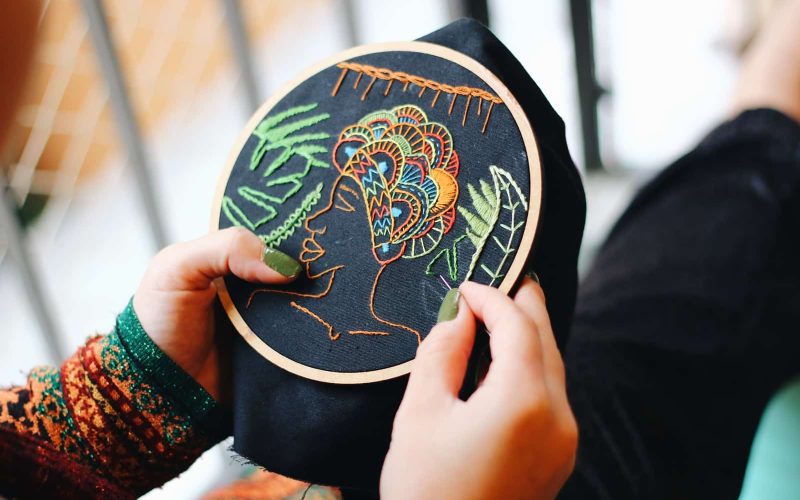Are you interested in learning embroidery? Or if you want to know more about it.
Then this is the article for you, as we shall discuss the different types of embroidery and what it entails.
You know, in addition to being a decor, embroidery can also serve as a form of art therapy; exciting, right? Let’s get into it.
What is Embroidery?
Embroidery is simply a craft that uses needles and thread to decorate a piece of fabric. The best materials are silk or cotton.
The beautiful patterns on these fabrics give them a wonderful texture and colorful look.
What Are the Tools You Need?
The essential tools for embroidery are fabric, frame, needle, and thread.
But there are more tools and specialized equipment for different fabric types and the kind of embroidery you’re working on.
Some of this other equipment are:
- Embroidery hoop
- Laying tools
- Drawing materials
- Tracing papers
- Seam ripper
- Magnifier
- Thread organizer
- Tweezers
- Hand towels
- Ruler
Some of the tools are further divided into different types. Examples are:
- Scissors: Dressmaker’s scissors, pinking scissors, ball-pointed scissors, appliqué scissors, and micro-tip scissors.
- Needles: Chenille, tapestry, and beading needles.
- Embroidery Thread: This includes pearl cotton, knitting yarn, silk thread, Sachiko thread, and crochet thread.
Different Types of Embroidery
Embroidery is grouped into five categories: blackwork, whitework, cross stitch, stumpwork, and Crewel embroidery. Let’s get started!
1. Blackwork Embroidery
Blackwork is the stitching of black thread on white fabric (cotton or linen).
Although it’s more about geometric patterns, you can use them in different colors, yarns, and fabrics. Yes, you can now work blackwork on an even-weave cloth.
Blackwork is also known as Spanish blackwork. This is due to Catherine of Aragon, the queen of England then (1509-1533), who showed her likeness for the embroidery.
The stitches primarily used in blackwork embroidery are the back and Holbein stitches. However, you can also sometimes use the stem and cross stitches.
Materials for Blackwork Embroidery
- Tapestry needles: This is one significant difference between blackwork and the other types of embroidery. Tapestry needles make it easier for you to use back stitches to make designs.
- Threads: You can use cotton, silk, twisted, and embroidery floss.
- Embroidery scissors
- Embroidery hoops
- Fabric
2. Whitework
As the name implies, whitework embroidery uses white thread on white fabric.
It dates back to the late 1800s when women used it to design their gowns and household linens.
Although the material used in whitework changes over time, the embroidery itself is still in vogue.
The stitches used in whitework embroidery are Chain, back, satin, stem, and herringbone.
Whitework Embroidery Materials
- Natural fabrics(cotton or linen)
- Border special thread or floss thread
- Magnifying light
- Needles
- Scissors
- Embroidery hoops
3. Cross Stitch
This technique involves working two stitches diagonally across one another. Cross stitch is still the easiest to learn among the different types of embroidery.
There are traditional and modern designs since it has been around for quite a long time.
It’s best done on Aida fabrics, as they allow you to get symmetrical stitches.
Cross Stitch Materials
- Aida fabric
- Linen
- Embroidery thread
- Embroidery hoops
- Needles
4. Stumpwork
Stumpwork, also called raised work, is one of the different types of embroidery.
It uses different materials and techniques to form a figure or tell a story.
The techniques include beadwork, padding, needle lace, counted work, and raised stitching.
Ancient stumpwork stitchers did a lot of free-hand stitching and drawing. Their designs reflected their preferences or core values.
Stumpwork Materials
- Small size needle
- Fabric
- Wire cutters
- Darning needles
- Floral wire
- Hoops and frames
- Tweezers
- Thimble
5. Crewel
Crewel embroidery means wool embroidery. Crewel was taken from the Welsh word ‘krua,’ which means wool.
Crewel embroidery is a surface type of embroidery that uses wool to follow a design pattern on a piece of fabric.
The stitches used in crewel embroidery include straight, satin, running, and French knot.
Crewel is the most difficult type of embroidery to learn. However, it is ideal for clothes, curtains, pillows, and wall hangings.
Crewel Embroidery Materials
- Crewel needles
- Crewel yarn
- Hoops or frames
- Thimble
- Scissors
- Fabric
- Magnifier
Importance of Embroidery
- Patience – It helps build patience and get you disciplined
- Creativity – Embroidery showcases the creative part of you and helps transform your ideas
- Inexpensive – Unlike other works, embroidery is easy to start. You’re good to go as long as you have your fabric, needle, and thread!
- Therapy is a form of relaxing the mind and focusing on yourself.
- Prevents stress and anxiety
- It beautifies our clothes and household furniture.
Conclusion
Although embroidery can be time-consuming work, it’s fascinating work.
Knowing about the different types of embroidery can also help you choose the one you’d like best.
Do you have any experience in embroidery? Tell us in the comment section below. Thanks for reading!








